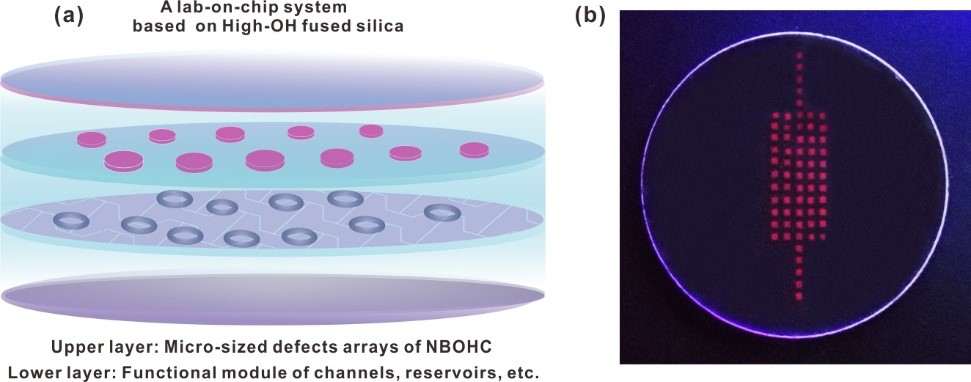Ultrashort laser pulses induced point defects in glass is always one of the hot topics in the field of laser processing materials. Point defects are closely related to density, refractive index, absorption and luminescence properties of glass. Along with the development of ultrashort laser, point defects related structure changes have enabled the preparation of functional photonic materials and devices in glass.
Recently, the research group in Shanghai Institute of Optics and Fine Mechanics (SIOM), Chinese Academy of Sciences (CAS), reported tunable point defects in hydroxyl fused silica enabled by ultrashort laser pulses for anti-counterfeiting and functional module fabrication. The result was published in Optical Materials Express.
In their experiment, high, middle and low hydroxyl fused silica were subject to ultrashort pulsed laser irradiation. Three different kinds of point defects-SiE′, ODC (II) and non-bridging oxygen hole center (NBOHC) were generated. Ultrashort laser pulses were proved to selectively destroy strained Si-O bonds and hydroxyl groups, thus enhancing the generation of SiE′ and NBOHC.
Researchers found that, as a luminous defect center, NBOHC creation density could be precisely regulated in a large range depending on hydroxyl content, laser power and pulse duration. Optimized by laser condition, high-OH fused silica could work as the extraordinary host for NBOHC, and NBOHC could give stable red photoluminescence. Based on ultrashort pulsed laser fabrication and defect manipulation technique, anti-counterfeiting and lab-on-a-chip applications were advocated on high-OH fused silica.
This work provides a novel method for anti-counterfeiting in transparent materials, and also facilitate the application of point defects for biomedical assays based on lab-on-a-chip.
This work is supported by the National Key Research and Development Program of China, and National Natural Science Foundation of China.

High-OH fused silica with a barcode. (Image by SIOM) 
(a) A schematic lab-on-chip system and (b) a fabricated arrays of micron-sized defects of NBOHC. (Image by SIOM)
Article website:
https://doi.org/10.1364/OME.391660
Contact:
Mr. CAO Yong
General Administrative Office
Shanghai Institute of Optics and Fine Mechanics, CAS
Email: caoyong@siom.ac.cn